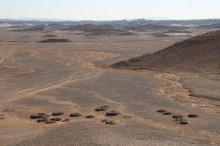
Séance du séminaire Espaces, villes et sociétés
Intervention de Julien Cooper (Macquarie University, Sydney)
Répondant : Robin Seignobos (Université Lumière Lyon 2)
- vendredi 18 octobre 2024 - de 15h à 18h - salle Reinach - salle Reinach - MOM - entrée par l'Université de Lyon2 - 86 rue Pasteur - Lyon 7e / et en visioconférence (pour obtenir le lien zoom écrire à : anna.cannavo@mom.fr)
- affiche (.pdf)
Despite being in the shadow of famous urban centres of Egypt and Nubia, the deserts east of the Nubian Nile, ‘the Atbai’, have only been sparsely explored, largely due to their remote terrain and difficulty of access. A new project combining wide area surveys with remote sensing and community engagement has highlighted the common patterns of ancient habitation across the desert, while also documenting widespread destruction to local heritage from modern goldmining activities.
Initial work has uncovered successive and complex archaeological profiles in the Atbai, from widespread Neolithic rock art sites, to pharaonic goldmines, and extensive cemeteries and settlements in late antiquity. The Atbai was constantly changing and was subject to pronounced climatic shifts, and affected by the imperialism of new political blocs (New Kingdom Egypt, Roman Egypt, Arab-Islamic Caliphate). The most important changes by far, however, are the introduction of new domesticates in local nomadic pastoralist societies, especially the dromedary. Several ‘crescendos’ in the archaeological and historical record are clearly visible, the most obvious of which is the apogee of local nomadic power in late antiquity, c. 300-900 CE. This presentation will take a longue durée approach to elucidating the historical geography and habitation of the Atbai desert, stressing unanswered questions relating to climate, history, and imperialism in a nomadic setting.